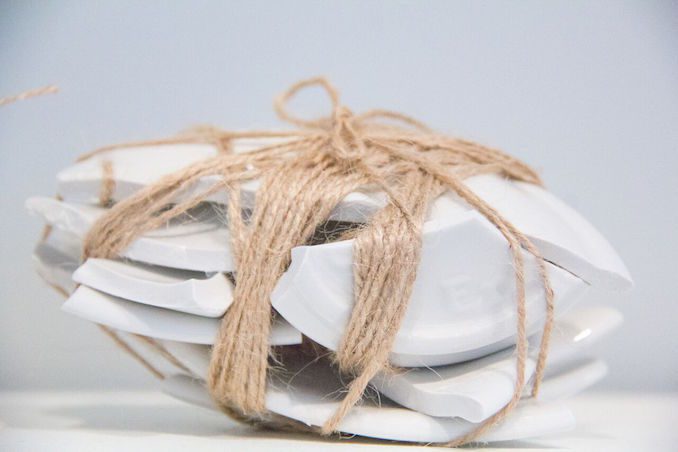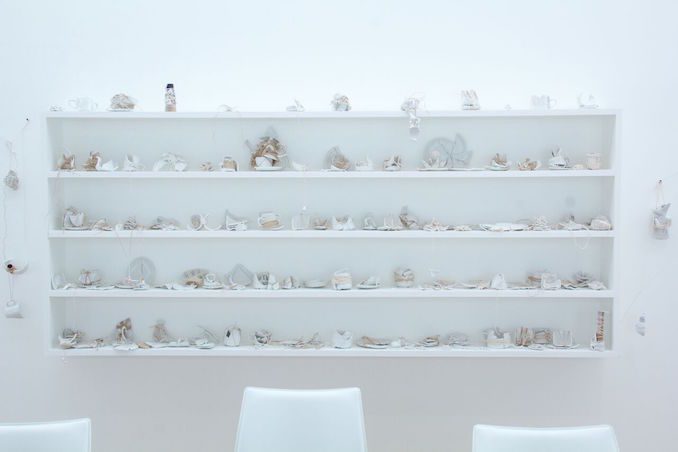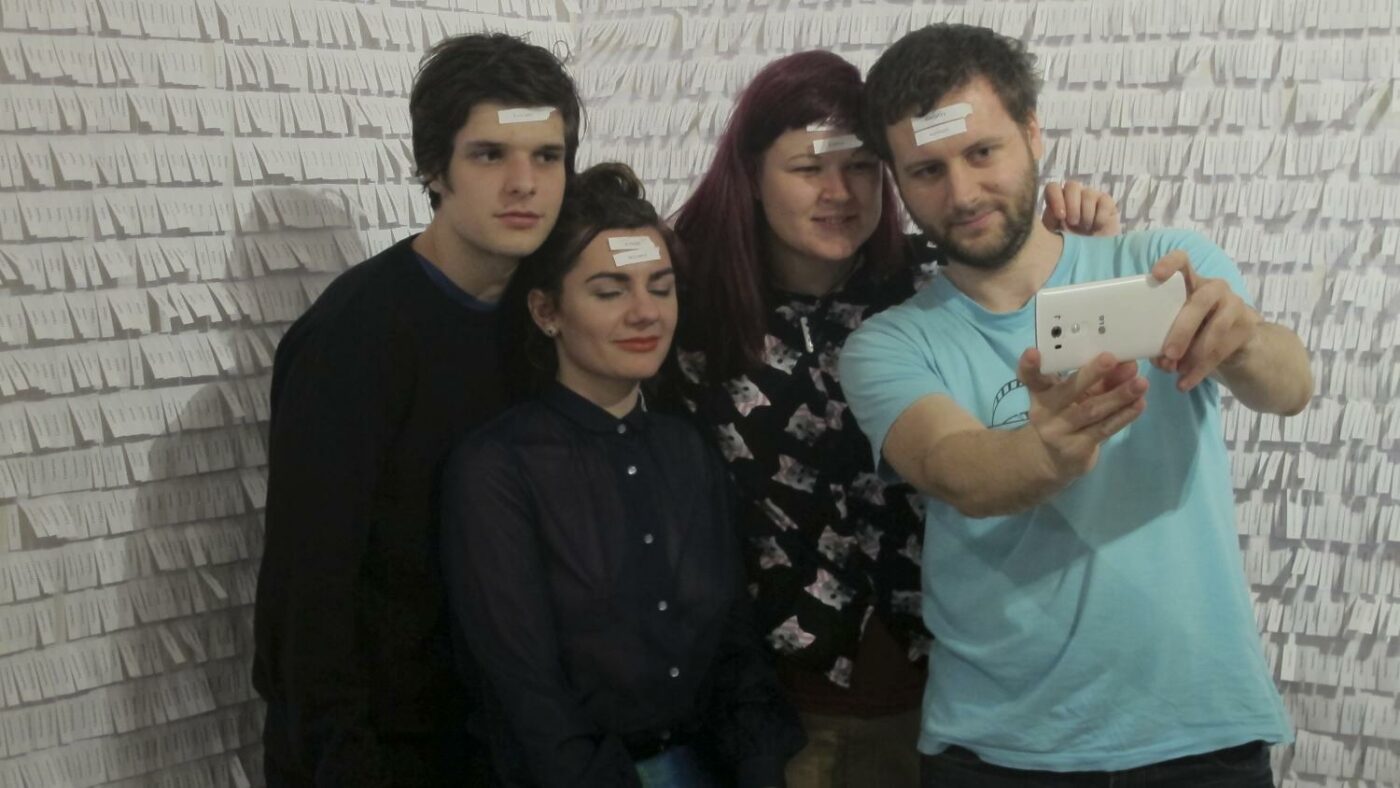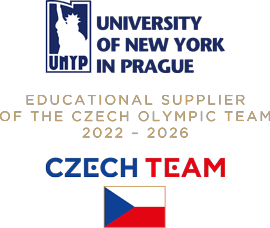Participatory art projects turn viewers into co-creators

I would like to introduce my readers to art projects that involve the audience in one way or another. Such participatory projects have been gaining more and more ground; we live in times of great social, humanitarian, political, and environmental challenges, and artists have an important role to play in bringing these challenges to the attention of the audience. “Great art is that which springs from necessity…” wrote Rainer Maria Rilke. It is this necessity which makes people participate in art projects of this kind, and reflect the pressing issues of the world.
By participating, the public becomes empowered to enter the creative process. Through their own insights, engaged viewers challenge their assumptions and undergo deeper self-reflection into complex issues. Socially and politically-charged topics are particularly well-suited to participatory art projects.
The world-famous artist Yoko Ono demonstrates the active participation process in her work. Ono creates projects which are often politically charged, where visitors actively participate in and co-create her art pieces.

Yoko Ono, Mend Piece, 1966 / 2018, © Yoko Ono. Photo: Tara Fillion
In Ono’s “Mend piece for the world” project (Black Mountain College Museum + Arts Center, 2018), visitors were asked to participate by gluing together broken white ceramic objects, which the artist later placed on a display shelf. She provided the specific instructions: “Mend carefully. Think of mending the world at the same time.” By co-creating the final installation of the mended ceramic pieces, participants were able to experience a new level of critical self-reflection by realizing how everyone can help in their own way to make the world a better place. “Our attention is redirected into ideas instead of appearances.” (Davidson, 2018)

Yoko Ono, Mend Piece, 1966 / 2018, © Yoko Ono. Photo: Tara Fillion
Just as for the Fluxus movement philosophy, the final product is a result of a specific process of thinking, which is more important than the end result. We can refer to art based on ideas as conceptual art. Such ideas were established already much earlier by the Dada movement, founded in Zurich in 1916. One of the artists who stood at the beginning of this “…subversive and irreverent…” movement “…which has shaken society’s notions of art and cultural production…” (Kuenzli, 2006) was Marcel Duchamp, widely considered the father of conceptual art. In the participatory art, first, there needs to be established a strong idea to draw interest and the need to participate.
In my teaching practice, first, I try to work with students to teach them how to establish the process of developing strong ideas. I recommend practicing a way of thinking called “mind mapping.” The term was originally coined by a British author and educator Tony Buzan. He is the inventor of this method, which he was developing since the 1970s. The technique “maps” our minds. Ideas typically do not develop in a linear, straightforward way but in a rather chaotic way, overlapping and layering. Our brain also functions more effectively if we use visual images, recording the flow of ideas in a structured way onto a piece of paper. Ideas can generate more ideas through associations. The mind mapping process can be successfully used as a powerful tool not only to develop a range of creative ideas but also to study or work.
In my artistic practice, community-oriented projects developed gradually. Even though my formal training was in Fine Arts and I graduated from the Academy of Fine Arts in Prague, the Czech Republic in 1982, I happened to live for over eleven years in Canada during the 1980s and 1990s, where I also developed skills in the advertising business. This experience of many years of working as an art director influenced me greatly in the field of Fine Arts, too. It was only much later that I realized how instrumental for my artistic thinking the advertising practice was. It was mainly the way to develop and generate creative ideas, which helped me in gaining a structured and conceptual way of thinking. A big idea is the main aspect of the creative outcome. When I left the advertising business in 2008 to focus mainly on my art projects, I started to teach at the same time at UNYP. I felt a strong need to share my experiences and pass my knowledge to young minds.

Alena Foustkova, Visual poetry of Jan Skácel, 2014, © Alena Foustkova. Photo: Alena Foustkova
The first of my art pieces associated with the idea of participation were objects made from open books glued to a two-dimensional surface of a supporting board (2007 – 2014). The books could be “read” by the audience or just the pages flipped. The creative idea behind these pieces was to show how books have been gradually losing their importance in our lives and are becoming merely empty containers decorating our bookshelves (for many).
Another early participatory project where I tested the possibilities of interaction with the audience consisted of a wall covered by hand-made paper bags, which I glued from various newspapers with controversial articles. The instructions asked the viewers to select one paper bag with text that bothered them, blow it up, bang it, and place it back on the wall. The installation changed gradually by the interventions of the audience. (2011)

Alena Foustkova, “Do you care?”, 2011, © Alena Foustkova. Photo: Alena Foustkova
One of the largest projects in which I involved participation, and active involvement of the audience was called “Dictionary” (2015 – 19). I presented the original installation in the Centre for Contemporary Art, DOX, Prague, Czech Republic, in a group exhibition called HateFree. (2016) I have recreated the piece since then, many times, extending it to other European countries like Slovakia (2016) and Germany (2017).

Alena Foustkova, Dictionary, 2015, © Alena Foustkova. Photo: Alena Foustkova

Alena Foustkova, Dictionary, 2015, © Alena Foustkova. Photo: Alena Foustkova
The creative idea reacted to the large wave of refugees entering Europe at that time. The exodus sparked strong support on the one hand, but also strong opposition on the other. The opposition was often expressed with hate, and I could see how human behavior changed, often into irrational reactions. Based on my experience and a strong feeling of necessity, I developed a participatory creative idea. The concept was based on connecting our feelings to words that express acceptance, tolerance, and compassion, and words, which expressed anger, hate, and intolerance to others. The words were chosen by me in a subjective way from a large English-Czech dictionary, and I took adjectives that could be more meaningful in relation to each person’s feelings. The way the words were displayed resembled small cut-up strip-leaflets taped to the poles on the street when someone wants to sell something leaving their phone number. The person interested in participating is asked to take one of the positive and one of the negative leaflets off the large panel of over nighty words to select from on each side. The individual words were prepared by me first in a computer, multiplied, and cut into strips from A4 pages with the help of volunteers. Since the installation in DOX covered two large walls from top to bottom, there were thousands of those words to be cut up and glued one-by-one cut-up strip onto the wall. I realized that I needed to ask some volunteers to help me with all the cutting and finalizing the large-scale piece. This experience turned out into a rewarding community time for everybody involved. We sat around a large round table, cutting, chatting, just as it used to be customary in the past when people naturally gathered in villages to spend time together. Most of the volunteers helped also glue all the words to the walls, which took around four days of work. Then the visitors of the exhibition became the next active participants and co-creators when they had to decide which one word they wanted to be and which one they did not want to be. They would rip off those words and kept them to themselves. Gradually, the walls started to change to reveal the empty places of the words which most people wanted or did not want to be.

Alena Foustkova, Dictionary, 2015, © Alena Foustkova. Photo: Alena Foustkova
Through the interactive way of working with creative ideas, I have discovered new layers of communication that my pieces can add to the project experience. This dimension coming out of the necessity, turns a passive viewer into an artist and co-creator. I believe that this active involvement is giving art an important role as a facilitator of critical thinking and looking for deeper meaning. Art can bring again the joy of connecting with it, which many people might have lost due to the complexity of the contemporary art scene.
Bibliography
Foustkova, A. (n.d.). The Work of Alena Foustkova. [online] Alenafoustkova.com. Available at: http://www.alenafoustkova.com/.
Black Mountain College Museum + Arts Center. (2018). MEND PIECE FOR THE WORLD: A PARTICIPATION ART WORK BY YOKO ONO – Black Mountain College Museum + Arts Center. [online] Available at: http://www.blackmountaincollege.org/mend-peice-world-participation-art-work-yoko-ono/.
Davidson, S. (2018). Yoko Ono at the Gardiner Museum reminds us that nothing is truly broken. [online] Toronto Guardian. Available at: https://torontoguardian.com/2018/03/yoko-ono-gardiner-museum/.
Encounters-arts.org.uk. (2019). Participatory Practice – Encounters. [online] Available at: https://www.artsadmin.co.uk/profiles/encounters/
Kuenzli, R. (2006). Dada. London: Phaidon.
Tuning Document: Participatory Art Practice in Europe. (2017). 1st ed. [ebook] Lyon: Gothe Institut Lyon, p.7. Available at: https://www.artworksalliance.org.uk/awa-resource/tuning-document-participatory-art-practice-in-europe/.
Van Vliet, V. (2009). Mind Mapping. Retrieved [insert date] from ToolsHero: https://www.toolshero.com/effectiveness/mind-mapping-buzan/
This is an edited version of an article originally published in the issue of December 2019 in the Diálogos com a Arte – Revista de Arte, Cultura e Educação, Viana do Castelo, Portugal.
Written by: Alena Foustková
Related Articles
UNYP Chronicle Newsletter
The e-mail address you provide will be used only to send you the newsletter. Your privacy is important to us.
For more information download our UNYP Brochure.

Contacts
University of New York in Prague
Londýnská 41, 120 00 Praha
ID no: 25676598
Phone:
+420 224 221 261
![]() Skype
Skype
Email: unyp@unyp.cz







